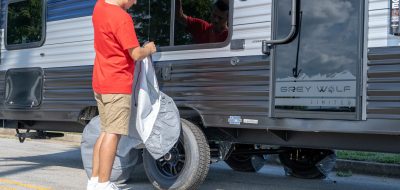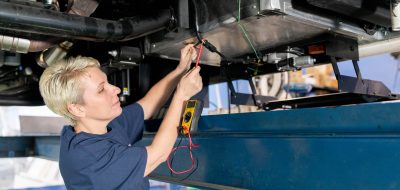 Braking What’s Behind You Makes Towing Safer
Braking What’s Behind You Makes Towing Safer
Whether you tow a car behind your motorhome or a 5th wheel or travel trailer behind your truck, the weight of the towed item significantly impacts your stopping distance and time, both affecting the safety of your towing arrangement.
Laws of Motion
The second law of motion states that mass times acceleration equals force. When applied to a towed vehicle or trailer, you can easily calculate the force of the car or trailer on the tow vehicle. Multiply a 3,000 lb. vehicle (mass) times 65 MPH (acceleration) and you get the kinetic energy of a quarter stick of dynamite acting like a battering ram on the rear of your motorhome or truck as you try to stop the rig. That’s why most states and provinces require supplemental tow brakes on towed vehicles and why most 5th wheel gooseneck, travel utility and equestrian trailers have electric tow brakes incorporated into the wheel assembly.
The brakes on a motorhome or tow vehicle are not designed to stop that vehicle and a 3,000 to 10,000 lb. load behind it. Towing without supplemental towing brakes quickly stresses tow vehicle brakes, resulting in overheating and possible brake failure. Stopping time and distance are much longer, putting you at risk of an accident if you can’t stop in time.
Types of Supplemental Braking
For motorhome owners towing a dinghy behind their coach, maximizing safety and control lies in a towed car supplemental braking system. Options include a permanently-mounted “direct” system such as the BrakeMaster or a portable system such as the EvenBrake or AddaBrake, all from Roadmaster. A direct system activates along with the hydraulic or air brakes on your motorhome each time you press the brake pedal, applying the towed car’s brakes proportionally with the coach brakes. A direct system is ideal if you only tow one vehicle behind your motorhome. A portable system is a good choice if you tow more than one vehicle behind your motorhome or change towed vehicles often. Portable systems are activated via a microprocessor (EvenBrake) or by the motorhome tail lights (AddaBrake), using an air cylinder to press the towed vehicle’s brake pedal to slow the dinghy.
For those towing a 5th wheel travel trailer or other type of trailer, an electric trailer brake controller mounted on the tow vehicle dash activates the drum type brakes on the trailer’s wheels by sending an electric current to the brake assemblies. The strength of the electric current determines the braking pressure applied. The brake controllers wire into the tow vehicle’s electrical system and sense the need for braking either through an inertia-based pendulum device like the Hayes Energize Ill brake controller or electronically like the Tekonsha P3 proportional brake controller. All brake controllers also incorporate a manual override so you can apply additional braking power to your trailer’s brakes when needed, such as in an emergency stop.
Using and maintaining supplemental towing brakes increases your margin of safety out on the road. It also saves you money by keeping your tow vehicle’s brakes from wearing out prematurely, and keeps you in compliance with towing regulations in the U.S. and Canada. Peace of mind on the road is worth the investment in a supplemental tow braking system you can rely on every time you press the pedal.




